November – Looking Back On The Occupied Wall Street Journal 10 Years After the Eviction of Zuccotti Park
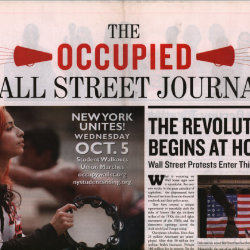
11 November 2021
By John C. Harris
Ten years ago today, on the morning of November 15, 2011, New York City Police Department officers, equipped with riot gear, pepper spray, and backed by a mayoral ordinance, advanced from their perimeter position surrounding Zuccotti Park. As news cameras rolled that morning, at roughly 1am, the police used riot gear and pepper spray to beat back the civilian group who met the advance of the militarized force with linked arms. The goal of the NYPD was to evict the demonstrators and halt the momentum behind the global “occupy” movement.
For over a month, the park, known to protestors as Liberty Square, filled with its many occupants, their shelters, and their buzzing energy, received international media attention.Their goal was to change the world.
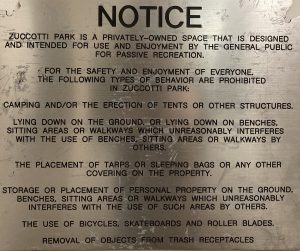
(During Occupy Wall Street the official notice at Zuccotti Park was changed for this sign. Its language was altered to include a ban of items that made up the encampment. The sign is now on display at MoRUS.)
In the wake of the 2008 financial crisis, activists organized to raise awareness of the effects of unchecked capitalism such as crushing wealth inequality, a political process corrupted by corporate influence, and exploitative banking practices. An initial call to occupy wall street was put out in a July 2011 Adbusters publication and the planning began immediately. The occupation of Zuccotti park began on September 17, 2011 with a 2,000 person march on the financial district of Manhattan. The activists maintained control of the park for nearly two months before their eviction. In the meantime, they started an international movement with lasting political implications. Within weeks similar occupations occurred in 82 different countries. Their familiar slogan, “We are the 99%,” has been a core principle of progressive economic initiatives over the past decade.
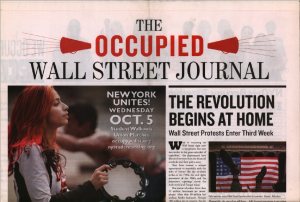
(Cover of Occupied Wall Street Journal Issue # 1, Activist Publications Collection at MoRUS)
Zuccotti Park, transformed into a society of its own; a complex encampment founded on powerful ideals contained within the .75 acre plaza. It was a centrifuge of change within the shadows of the world’s largest financial institutions. In a sense they were getting at the root of their frustrations by confronting the physical arena that housed the companies which implemented the practices they detested. By the third week of the occupation the first issue of The Occupied Wall Street Journal was distributed. The paper quickly established itself as an organ of the movement. It provided insight to the philosophy of the occupy movement and provided updates from encampments around the world. The Occupied Wall Street Journal press project represented one of the strongest forms of central narrative to the largely decentralized yet global movement by organizing a coherent message upon international through lines. In our recent overhaul of the archive here at the Museum of Reclaimed Urban Space we uncovered and preserved the first six issues of The Occupied Wall Street Journal.
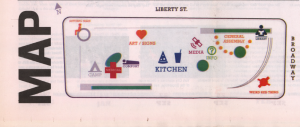
(Map of the Occupy encampment in Zuccotti Park from the OWSJ, Activist Publications at MoRUS)
According to the paper, the Declaration of the Occupation, which was approved by consensus on September 29th 2011 at the occupation’s general assembly, outlined their cause by asserting, “As one people, united, we acknowledge the reality: that the future of the human race requires the cooperation of its members; that our system must protect our rights, and upon corruption of that system, it is up to the individuals to protect their own rights, and those of their neighbors; that a democratic government derives its just power from the people, but corporations do not seek consent to extract wealth from the people and the Earth; and that no true democracy is attainable when the process is determined by economic power. We come to you at a time when corporations, which place profit over people, self-interest over justice, and oppression over equality, run our governments. We have peaceably assembled here, as is our right, to let these facts be known.” Other explicitly stated grievances ranged from the foreclosure processes undertaken during the 2008 financial crisis, animal rights abuses, the militarization of the police force, and blocked access to generic forms of medicine within the healthcare system. The declaration concludes with a global call to action encouraging those capable of using their right to peaceably assemble to participate in the processes of generating change.
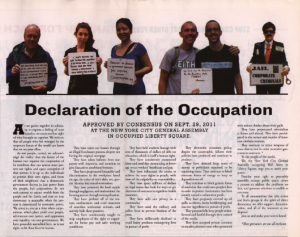
(Declaration of the Occupation published in the OWSJ, Activist Publications at MoRUS)
Our collection reveals The Occupied Wall Street Journal was published at least five more times through the spring of 2012 with at least two publications coming after the eviction. Included within the paper’s run was the November 2011 “Poster Forum” which featured prints of artwork created to bolster the movement. The posters provided encouragement and inspiration to the activists in Liberty Square. Undoubtedly the messages contained within the posters would have been a welcomed sign to keep up the good work after the activists were evicted.
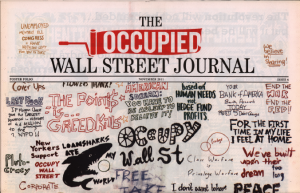
(Cover of the Poster Forum Issue of the Occupied Wall Street Journal, Activist Publications at MoRUS)
The final Occupied Wall Street Journal is dated Spring 2012. It is the May Day edition and the paper used the occasion, a critical date which often coincides with mass demonstrations of laborers and activists of all stripes, to recap the previous eight months of the Occupy movement. The paper sticks to its original tenets encouraging others to get involved with the political process and reports on the status of the movement as many of the international sites were evicted. The Occupied Wall Street Journal provided an inspiring and cohesive message to a rapidly evolving movement. A movement that ten years later, despite its evictions and marginal odds against the financial and political machines, affected great change. Occupy Wall Street forced an international shift in the narrative around the economy. Once radical talking points are now well accepted ideas. A year after the occupation of Zuccotti park, here in New York City the OWS movement prepared the residents to organize and mobilize in the face of FEMA’s failures after Hurricane Sandy in the form of Occupy Sandy. And on an individual scale, the information that Occupy generated as well as the media attention it received provided the next generation of activists a proving ground to cut their teeth upon: it remains a premier example of what a decentralized, horizontally structured movement founded on progressive ideas that navigates the decision making process through participation and consensus can achieve.
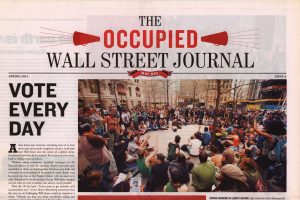
(Cover of the May Day Issue of the Occupied Wall Street Journal, Activist Publications at MoRUS)
